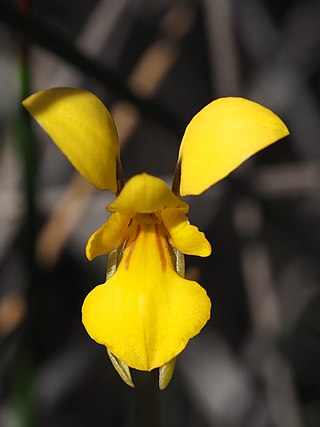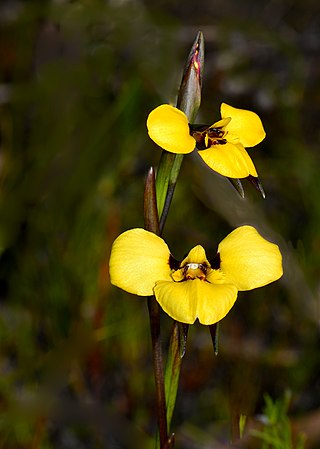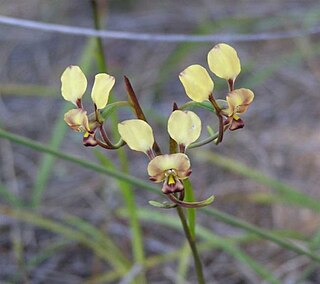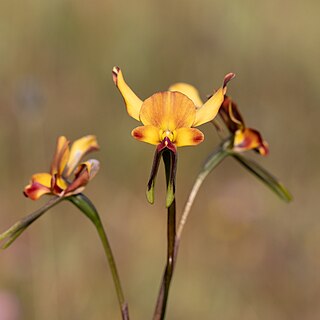Diuris maculata, commonly known as the spotted doubletail, is a species of orchid endemic to New South Wales. It has up to two or three folded leaves and a flowering stem with up to eight yellow flowers with brown to blackish markings. It is similar to D. pardina which has darker flowers with larger brown markings.

Diuris brumalis, commonly known as the winter donkey orchid, is a species of orchid that is endemic to the south-west of Western Australia. It is one of the first species of donkey orchid to flower in Western Australia each year and its flowers have been shown to attract the same insects that pollinate other species, but without offering a food reward.

Diuris drummondii, commonly known as the tall donkey orchid is a species of orchid which is endemic to the south-west of Western Australia. It is the tallest Diuris and is distinguished from the similar Diuris emarginata by its larger, more widely spaced flowers. The flowers are pale yellow with brown markings.

Diuris filifolia, commonly known as the cat's face orchid, is a species of orchid which is endemic to the south-west of Western Australia. It is one of the rarest Diuris in Western Australia, sometimes flowering in large numbers but only after hot summer fires.

Diuris aequalis, commonly called the buttercup doubletail, is a species of orchid which is endemic to New South Wales. It has two rolled leaves and spikes of two to five golden-yellow to orange flowers and is currently listed as "Endangered".

Diuris concinna, commonly called the elegant donkey orchid, is a species of orchid which is endemic to the south-west of Western Australia. It has up to five linear leaves at its base and up to five pale yellow flowers with brown markings. It is found along the south coast, often growing in areas that are flooded in winter and flowering more prolifically after fire the previous summer.
Diuris eburnea is a species of orchid that is endemic to the south-west of Western Australia. It has between four and six linear leaves and up to eight pale yellow to cream-coloured flowers with reddish markings. It is only known from near the Arrowsmith River north of Eneabba.
Diuris flavescens, commonly called the pale yellow doubletail or Wingham doubletail, is a species of orchid which is endemic to a small area in New South Wales. It has two linear leaves at its base and up to five pale yellow flowers with dark brown markings. Fewer than 200 plants survive in grassy forest near Wingham.

Diuris laevis, commonly known as the nanny goat orchid, is a species of orchid that is endemic to the south-west of Western Australia. It has between four and eight leaves and up to six pale yellow flowers which usually have reddish-brown markings. It has an unusually short dorsal sepal and wide labellum and is relatively common between Bunbury and Albany.

Diuris pedunculata, commonly known as the small snake orchid, is a species of orchid which is endemic to New South Wales. It usually has two leaves at its base and one or two yellow and orange flowers with purple markings. It originally occurred in scattered populations between Tenterfield and the Hawkesbury River but because of habitat loss is now only known from the New England Tableland.

Diuris purdiei, commonly known as Purdie's donkey orchid, is a species of orchid that is endemic to the south-west of Western Australia. It has between five and ten leaves at its base and up to eight pale yellow flowers with reddish-brown or purplish markings. It mainly grows in swampy areas and only flowers after fires the previous summer.

Diuris recurva, commonly called the mini donkey orchid is a species of orchid that is endemic to the south-west of Western Australia. It has one or two leaves at its base, up to six small pale yellow and brownish flowers and grows in winter-wet places between Badgingarra and Kalbarri.

Diuris brachyscapa, commonly known as western wheatbelt donkey orchid, is a species of orchid that is endemic to the south-west of Western Australia. It has two or three linear leaves and a flowering stem with up to four pale yellow flowers with brown markings.
Diuris brevis, commonly known as short-nosed donkey orchid, is a species of orchid that is endemic to a restricted area in the south-west of Western Australia. It has two or three linear leaves and a flowering stem with up to four small yellow and brown flowers with a short labellum.
Diuris brevifolia is a species of orchid that is endemic to South Australia. It usually has one or two grass-like leaves and a flowering stem with up to five bright yellow and reddish-brown flowers with purple stalks.
Diuris cruenta, commonly known as Kemerton donkey orchid, is a species of orchid that is endemic to the south-west of Western Australia. It has two or three linear leaves and a flowering stem with up to seven pale yellow and reddish-brown flowers, and is similar to D. tinctoria.

Diuris goonooensis, commonly known as Goonoo donkey orchid or western donkey orchid, is a species of orchid that is endemic to western New South Wales. It has one or two linear leaves at its base and up to eight yellow flowers with brown markings on each part of the flower.

Diuris hazeliae, commonly known as yellow granite donkey orchid, is a species of orchid that is endemic to the south-west of Western Australia. It has between two and four linear leaves and up to six bright yellow and reddish-brown flowers.
Diuris insignis, commonly known as dark bee orchid, is a species of orchid that is endemic to the south-west of Western Australia. It has between two and six narrowly linear to thread-like leaves and up to five yellow flowers with many dark red markings.

Diuris leopardina is a species of orchid that is endemic to south-eastern continental Australia. It has between two or three grass-like leaves of different lengths, and a flowering stem with up to five pale yellow to butter yellow flowers with reddish brown or purple marks and patterns, and leopard-like spots on the back.












